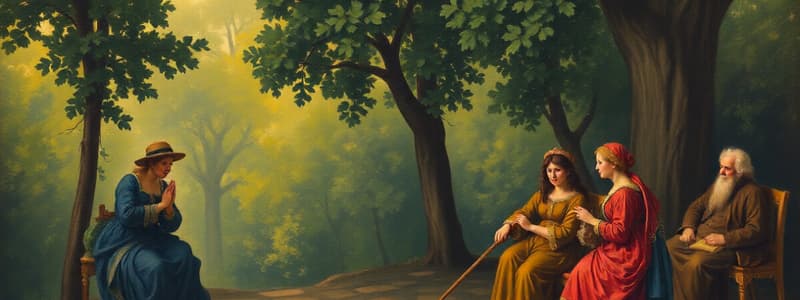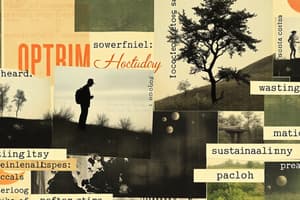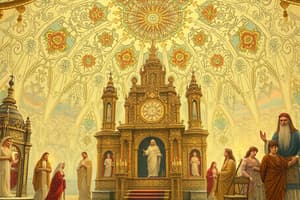Podcast
Questions and Answers
In 30,000 BC, the First Occupants crossed the Bering land bridge from Asia into ______.
In 30,000 BC, the First Occupants crossed the Bering land bridge from Asia into ______.
North America
The Algonquian way of life was primarily ______, as they constantly moved around following game.
The Algonquian way of life was primarily ______, as they constantly moved around following game.
nomadic
The Iroquois practiced ______ agriculture because the soil was very fertile in their region.
The Iroquois practiced ______ agriculture because the soil was very fertile in their region.
sedentary
The dwelling of the Algonquian people was known as a ______.
The dwelling of the Algonquian people was known as a ______.
The political organization of the Iroquois included a village ______ made up of men appointed by clan mothers.
The political organization of the Iroquois included a village ______ made up of men appointed by clan mothers.
The Inuit lived in ______ during the winter and tents during the summer.
The Inuit lived in ______ during the winter and tents during the summer.
The ______ society of the Iroquois was characterized by women being in control.
The ______ society of the Iroquois was characterized by women being in control.
In 12,000 BC, the First Occupants reached and settled in ______.
In 12,000 BC, the First Occupants reached and settled in ______.
The southern part of Quebec is known for its very fertile ______.
The southern part of Quebec is known for its very fertile ______.
Iroquoian men were responsible for hunting, fishing, and building ______.
Iroquoian men were responsible for hunting, fishing, and building ______.
The Inuit lived in very harsh frozen areas of northern Quebec and ______.
The Inuit lived in very harsh frozen areas of northern Quebec and ______.
The Algonquian women focused on domestic work including cooking and taking care of ______.
The Algonquian women focused on domestic work including cooking and taking care of ______.
First Occupants used animal skins to make ______.
First Occupants used animal skins to make ______.
The Iroquois Confederacy exemplifies a partnership known as a ______.
The Iroquois Confederacy exemplifies a partnership known as a ______.
The discovery of North America was partly due to the need to find new trade routes after the Turks took over ______.
The discovery of North America was partly due to the need to find new trade routes after the Turks took over ______.
Reciprocity is an essential aspect of gift-giving, creating both commercial and military ______.
Reciprocity is an essential aspect of gift-giving, creating both commercial and military ______.
John Cabot discovered the 'Great Fishing Banks of the ______' along the coast of Newfoundland.
John Cabot discovered the 'Great Fishing Banks of the ______' along the coast of Newfoundland.
European fishermen temporarily settled in Newfoundland as cod fishing and ______ quickly became an important economic activity.
European fishermen temporarily settled in Newfoundland as cod fishing and ______ quickly became an important economic activity.
Jacques Cartier's first voyage in 1534 explored the Gulf of ______.
Jacques Cartier's first voyage in 1534 explored the Gulf of ______.
One of Cartier's goals was to discover precious metals like ______ to increase France's wealth.
One of Cartier's goals was to discover precious metals like ______ to increase France's wealth.
Mercantilism is an economic policy in which the colony exists to provide raw materials, such as ______, to the Mother country.
Mercantilism is an economic policy in which the colony exists to provide raw materials, such as ______, to the Mother country.
The Catholic Church played a role in ______ for young children in New France.
The Catholic Church played a role in ______ for young children in New France.
The population of the Aboriginals decreased due to war and ______ brought by Europeans.
The population of the Aboriginals decreased due to war and ______ brought by Europeans.
Catholic missionaries aimed to ______ the Indigenous people to Christianity.
Catholic missionaries aimed to ______ the Indigenous people to Christianity.
Flashcards
Way of Life
Way of Life
The way a group of people live, including their customs, traditions, and beliefs.
Demographic
Demographic
The study of human populations, including their size, distribution, and changes.
Linguistic group
Linguistic group
A group of people who share a common language.
Subsistence Activity
Subsistence Activity
Signup and view all the flashcards
Dwelling
Dwelling
Signup and view all the flashcards
Physiographic region
Physiographic region
Signup and view all the flashcards
Matriarchal Society
Matriarchal Society
Signup and view all the flashcards
Patriarchal Society
Patriarchal Society
Signup and view all the flashcards
Iroquois Confederacy
Iroquois Confederacy
Signup and view all the flashcards
Alliances
Alliances
Signup and view all the flashcards
Rivalries
Rivalries
Signup and view all the flashcards
Gift-Giving
Gift-Giving
Signup and view all the flashcards
Oral Traditions
Oral Traditions
Signup and view all the flashcards
Traditional Dwellings
Traditional Dwellings
Signup and view all the flashcards
First Nations' Use of the Environment
First Nations' Use of the Environment
Signup and view all the flashcards
Roles of Men and Women in First Nations
Roles of Men and Women in First Nations
Signup and view all the flashcards
Mercantilism in New France
Mercantilism in New France
Signup and view all the flashcards
Jacques Cartier's Goals
Jacques Cartier's Goals
Signup and view all the flashcards
Impact of Fur Trading on New France's Population
Impact of Fur Trading on New France's Population
Signup and view all the flashcards
Cod Fisheries and Early Settlement in Newfoundland
Cod Fisheries and Early Settlement in Newfoundland
Signup and view all the flashcards
Scurvy
Scurvy
Signup and view all the flashcards
Roles of the Catholic Church in New France
Roles of the Catholic Church in New France
Signup and view all the flashcards
Consequences for Aboriginals in New France
Consequences for Aboriginals in New France
Signup and view all the flashcards
Cartier's Third Voyage
Cartier's Third Voyage
Signup and view all the flashcards
Study Notes
Important Terms to Know
- Economic: Deals with the financial aspects of a society or region.
- Cultural: Refers to the beliefs, customs, and traditions of a group of people.
- Political: Focuses on the systems of governance and power within a society.
- Social: Examines the relationships and interactions between people in a society.
- Cause: The reason something happens.
- Consequence: The result of an action or event.
- Way of Life: Describes how a group of people live, including their activities, beliefs, and traditions.
- Physiographic region: A geographical area defined by its landforms.
- Dwelling: A place where someone lives.
- Linguistic group: Individuals who speak the same language or a closely related group of languages.
- Subsistence Activity: The activities performed by a group of people to support their basic needs.
- Demographic: Statistical data related to a population (e.g., age, gender, location).
Bering Strait Theory
- First occupants crossed the Bering land bridge from Asia to North America around 30,000 BCE.
- Around 15,000 BCE, ice melted, forming a corridor allowing further migration.
- By 12,000 BCE, occupants had reached and settled in Quebec.
Algonquian Way of Life (Social and Political Organization)
- Nomadic lifestyle, constantly moving to follow game (hunting, fishing, gathering).
- Social structure was patriarchal (men/fathers in control).
- Dwellings were wigwams.
- Leadership (band chief) based on qualities like hunting skills and courage.
Iroquois Way of Life (Social and Political Organization)
- Sedentary lifestyle, staying in one place for a long time.
- Practiced agriculture (3 sisters: corn, squash, and beans).
- Social structure was matriarchal (women/mothers in control).
- Dwellings were longhouses surrounded by palisades.
- Leadership involved a village council comprising men appointed by clan mothers.
Inuit Way of Life (Social and Political Organization)
- Nomadic lifestyle, constantly moving to follow game (hunting seals, walrus, whale, caribou).
- Social structure was patriarchal (men/fathers in control).
- Dwellings were igloos (winter) and tents (summer).
- Also relied on parkas and dogsleds.
Roles of Men and Women (Iroquois and Algonquian)
- Iroquoian men: Hunting, fishing, building longhouses, trade, and community defense.
- Iroquoian women: Gathering, agriculture, childcare, cooking.
- Algonquian men: Fishing, hunting, making tools, canoes.
- Algonquian women: Gathering, childcare, cooking, clothing preparation, and homemaking.
Passing of Knowledge
- Elders passed on myths, legends, and history to the next generation to maintain cultural continuity.
- There was no written language system.
Gift-Giving
- Reciprocity was involved in gift-giving.
- It was a way to create trade and military alliances.
Alliances and Rivalries
- Alliances were partnerships between groups.
- Rivalries involved conflicts and/or competition between groups.
- The Iroquois Confederacy was one example of a lasting alliance.
European Exploration Motives (15th-16th Centuries)
- Blocked traditional trade routes to Asia by the Turks.
- Searching for new routes to Asia.
- Desire for wealth (gold) and increase in power.
- Missionary zeal to convert indigenous peoples to Christianity.
Cod Fisheries (Newfoundland)
- 1497: John Cabot discovered the Great Fishing Banks.
- European fishermen temporarily settled.
- Cod fishing and whaling became a major economic activity.
Voyages of Jacques Cartier
- Explored the Gulf of St. Lawrence.
- Claimed land for France.
- Explored the St. Lawrence River.
- One of his expeditions had several deaths due to scurvy.
Economy Policy - Mercantilism
- Colonies provided raw materials to the mother country.
- Manufactured goods from the mother country were sold to colonies and other countries for profit.
- Colony's economy was based on providing materials to the home country.
The Seigneurial System
- Method of dividing land in an orderly fashion, providing food and population.
- Land was divided into long narrow strips perpendicular to the St. Lawrence River.
Fur Trade
- The French were interested in establishing a colony to exploit the fur trade.
- Indigenous people hunted fur and traded with the French.
- French artisans would turn the furs into goods for sale.
Review - Chapter 1
- Question 1: Physiographic regions influenced aspects of the first occupants' societies (e.g., agriculture, settlements).
- Question 2 (a): Maliseet and Mi'kmaq moved regularly to follow resources and hunting/fishing.
- Question 2 (b): Camps near waterways because of access to water and fish.
- Question 3: The Iroquois' sedentary lifestyle linked to agricultural practices.
- Question 4: Leadership through chiefs reflected decision-making processes in First Nation societies.
- Question 5 (a): Oral tradition, storytelling, elders, and demonstrations passed on culture and knowledge.
- Question 5 (b): Crucial role in preserving culture and knowledge.
Review - Chapter 2
- Question 1: Colonization's economic role was based on mercantilism, providing raw materials to the home country.
- Question 2 (a): Company of One Hundred Associates initially tasked to develop the colony.
- Question 2 (b): Obligation to develop the colony and extract resources for the French state.
- Question 3: Alliance was an exchange of fur for military support and trade.
- Question 4 (a): One Hundred Associates obligation was related to the colonization process.
- Question 4 (b): Benefits of the company could have included trade advantages and some level of control over the region.
- Question 5 (a): The seigneurial system, a method of land division.
- Question 5 (b): Involved long narrow strips of land perpendicular to the St. Lawrence River, with rivers used for transportation.
Review Questions (cont.)
Further questions cover additional aspects and details, such as the role of the Catholic Church, effects of colonization on territories, factors impacting First Nation population decline, objectives of the royal government, and the role of the Sovereign Council.
Studying That Suits You
Use AI to generate personalized quizzes and flashcards to suit your learning preferences.





